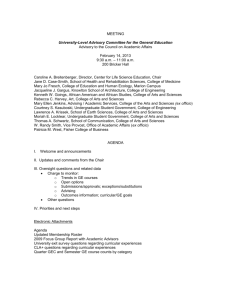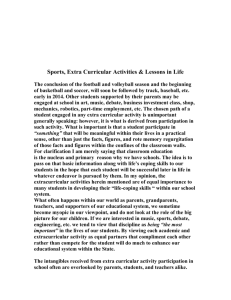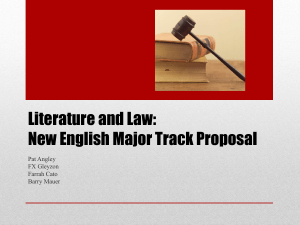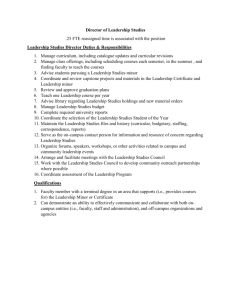EISNER-A Common Core for Education in the Arts
advertisement
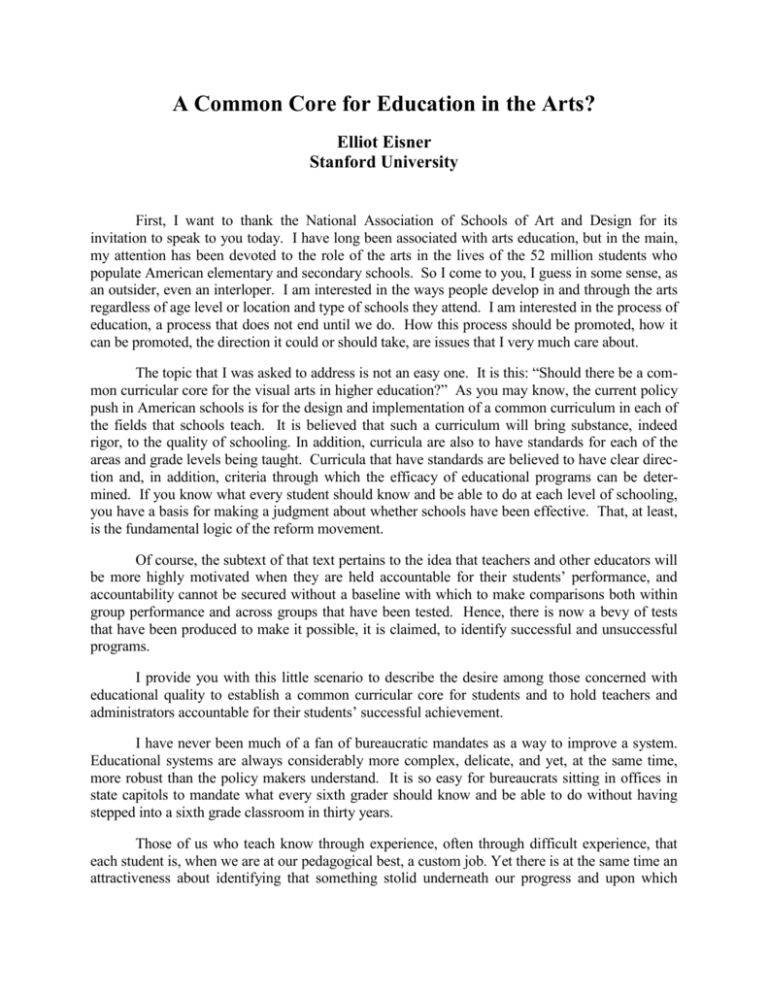
A Common Core for Education in the Arts? Elliot Eisner Stanford University First, I want to thank the National Association of Schools of Art and Design for its invitation to speak to you today. I have long been associated with arts education, but in the main, my attention has been devoted to the role of the arts in the lives of the 52 million students who populate American elementary and secondary schools. So I come to you, I guess in some sense, as an outsider, even an interloper. I am interested in the ways people develop in and through the arts regardless of age level or location and type of schools they attend. I am interested in the process of education, a process that does not end until we do. How this process should be promoted, how it can be promoted, the direction it could or should take, are issues that I very much care about. The topic that I was asked to address is not an easy one. It is this: “Should there be a common curricular core for the visual arts in higher education?” As you may know, the current policy push in American schools is for the design and implementation of a common curriculum in each of the fields that schools teach. It is believed that such a curriculum will bring substance, indeed rigor, to the quality of schooling. In addition, curricula are also to have standards for each of the areas and grade levels being taught. Curricula that have standards are believed to have clear direction and, in addition, criteria through which the efficacy of educational programs can be determined. If you know what every student should know and be able to do at each level of schooling, you have a basis for making a judgment about whether schools have been effective. That, at least, is the fundamental logic of the reform movement. Of course, the subtext of that text pertains to the idea that teachers and other educators will be more highly motivated when they are held accountable for their students’ performance, and accountability cannot be secured without a baseline with which to make comparisons both within group performance and across groups that have been tested. Hence, there is now a bevy of tests that have been produced to make it possible, it is claimed, to identify successful and unsuccessful programs. I provide you with this little scenario to describe the desire among those concerned with educational quality to establish a common curricular core for students and to hold teachers and administrators accountable for their students’ successful achievement. I have never been much of a fan of bureaucratic mandates as a way to improve a system. Educational systems are always considerably more complex, delicate, and yet, at the same time, more robust than the policy makers understand. It is so easy for bureaucrats sitting in offices in state capitols to mandate what every sixth grader should know and be able to do without having stepped into a sixth grade classroom in thirty years. Those of us who teach know through experience, often through difficult experience, that each student is, when we are at our pedagogical best, a custom job. Yet there is at the same time an attractiveness about identifying that something stolid underneath our progress and upon which specialization and diversification can be developed. The problem, as I see it, is to try to identify what is fundamental to a field if anything is, and to make sure that students have at least been exposed to it. At the same time, I think everybody here would agree that the last thing one wants coming out of schools of art is an army of students marching towards the same destination according to the beat of a single drummer. We want, in other words, students to follow their own drummer as they say. The problem is one of promoting individuation while at the same time promoting a sense of integration. When I was a student at the Institute of Design at the Illinois Institute of Technology, we had a foundation program. I don’t believe there was a question on anybody’s mind that the new recruits needed to be artistically socialized by having to deal with open ended and often difficult tasks that required some degree of technical skill and a high degree of imagination and problem solving ability. This foundation program dealt not only with drawing and graphics, but with threedimensional form, photography, and with shelter design. It was not clear which students would pursue which areas of the curriculum, but what was clear was that the faculty of the school believed it was important for students to have a common core. The same general rationale to curriculum decision making was expressed at the School of the Art Institute of Chicago, another institution I attended as a student. The foundation program at the School of the Art Institute of Chicago was quite different in spirit from what I encountered at the Institute of Design. The School of the Art Institute was, after all, a beaux-arts institution. Nevertheless, and maybe especially because it was a beaux-arts institution, that it had a heavy emphasis on drawing, on painting, on design, and on art history. We were expected to learn how to look in order to notice, we were expected to learn how to draw, we were expected to think about design, composition, layout, and all the rest. All of this was to be a foundation for later specialization. Judging from the work of the most talented students in the school, the curriculum seemed to work quite well. However, what is not clear since this was not a random field trial, was whether those talented students would have done just as well with a different program. Yet, I had no objection to what I encountered as a student. Indeed, I wasn’t thinking deeply enough about what I should study to have an objection to what was being provided. It was a meal, and it was a meal that I had the opportunity to consume, with great pleasure, I might say. Thus, it is clear to me that a common core certainly can be defined, at least in principle, for an individual faculty populating an individual art school. It is also possible that certain beliefs could be articulated regarding what students should learn in a nationally accredited school of art and design as a foundation for what is to come. I suspect that what I have described is not novel to most of you. I suspect that most schools have a common core for at least a part of the time. I could, of course, be wrong in these assumptions and in the discussion that follows, I expect that I will be corrected if my assumptions are erroneous. I also need to remind myself that I attended the Art Institute of Chicago from 1950 to 1953, and the Institute of Design from 1955-1956. There has been a lot of water under the bridge. We are living in different times. Indeed, it is because of the differences in the time at which we live that this question about a common curriculum core was raised in the first place. For some aestheticians, our conceptions of art, at least the conceptions of art that have long dominated modernism, are over. Art is supposedly dead and something else is taking its place, although I must confess I don’t know what that something else is. What I do know is that forms of work are being explored 2 with a no-holds-barred mentality. This is to say that since Marcel Duchamp, we have been engaged increasingly in an activity that has as much to do with ideas that form implies as much, perhaps more, than attention to qualities of visual form as such. If you’re not in on the ideas, the work is likely to be an enigma. I am reminded of Tom Wolf’s book The Painted Word, in which he speculates that theory has become so important in post-modern art that museums will in the future have very large placards explaining the theory needed to decode the work. What he said we were coming to was a situation where in museums in which you have very small paintings adjacent to huge explanations. Artists have been exploring forms that impose new challenges to percipients. In a sense, old assumptions will no longer do. Beauty is a casualty and it seems almost quaint to talk about beauty as a feature of a painting, a sculpture, a print. Conceptual art is often lean in character, something that feeds the ideational within us rather than the sensory from which many of us have secured so much pleasure. Given the shift in orientation from the visual to the ideational, is there a place for a foundation that is common? Can we legitimately talk about a common core when the assumptions that are employed in the making of art seem so radically different than they once were? Now I recognize that there has always been shifts in the formal features of work in the visual arts over the centuries and that the purposes and intended audience have also shifted. Yet, there is something similar in the ways in which a work is read, whether by Velasquez or Vermeer, or even from Picasso’s cubist period. There is a sensuous surface that one can relish and it was, I think for many of us, the taste secured from relishing the experience that works of art afforded us that provided the deep satisfaction secured from paying attention to them. And for some, of being able to create works that provided such satisfactions for others. Today we tend to be much more preoccupied, at least the elite do, with a message. We want to make a comment about a state of affairs and that comment often trumps the qualitative considerations that went into works made in the past. The point of my remarks thus far pertain to a kind of dilemma that I experience when I think about the topic I have been invited to address. I confess to you my sense of uncertainty. I confess to you my sense of unease in trying to find a happy reconciliation for a tension which I think is very real. That tension pertains to the desirability of fostering what is creative, imaginative, and surprising. Works of art, like works of science, have as one of their functions surprising those engaged in that work. Works of art and science provide the conditions through which new forms, new ideas, new perspectives, new explanations, new qualities can be made visible and shared publicly. Such an orientation to creative work does not seem to fit well with an approach to curriculum and teaching which assumes that everyone needs the same diet. And yet, diets can and in fact do share common features. We need not cook up individual meals for every student. The provision of a common set of tasks having similar goals can be addressed in very different ways. Again, when I was a student at the Institute of Design, we were asked to solve problems that made it possible for every student in that foundation class to arrive at a solution that was distinct and, indeed, even unique. In short, the door was wide open for the pursuit and development of our own individuality even though the program of expectations was common across students. Such curricular features are, I think, of fundamental importance in building a program for students who are expected to come up with ideas that are innovative, dare I say creative. What diminishes students’ development in the arts is an imposed set of expectations 3 that impedes ingenuity by holding forth a set of criteria that the work is to emulate. That is precisely what is wrong with so much of what is going on in the elementary and secondary school with respect to curriculum reform. Students respond to what they reportedly had learned by filling in a bubble sheet which can be machine scored. I don’t think we want machine scoreable outcomes coming out of art and design schools. So perhaps the tension about which I spoke is easing up a bit, but then again, perhaps not. Perhaps it is alright to build a program that has common tasks in a foundation course, but which permits multiple solutions, diverse interpretations, distinctive perspectives in addressing the problems students are asked to deal with. Maybe it is possible to have our cake and to eat it, too. Thus far I have been discussing the tensions in the idea of a common curricular core largely from the perspective of the arts. That, I suppose is to be expected. But it is important, also, to raise the question as to whether or not the common core should include academic subjects. Should the study of history be required? Should students have a course in aesthetics or in philosophy in general? Should the history of science be examined? Should students be required to read and discuss literature? Are there assets to such exposure? Perhaps a part of the answer to those questions rests on our conception of what school of art and design are expected to do. To what extent, for example, do such schools have an interest in the general education of the student? Are such schools essentially and for all practical purposes professional training institutions? And if they are, does a broad knowledge of the fields I have identified contribute to the quality of thinking that someone is able to do in his or her own art work or in his or her own appreciation and understanding of art? Put another way, should a common curricular core include academic subjects or are we talking only about knowledge and skills related to the creation and perception of art? How wide should the scope pf our curriculum be? Now curriculum decisions, like most decisions in life, do not come without trade-offs. The more time is devoted to what we might call academic subjects, the less time will be devoted to art making activities or to activities concerned with the perception and understanding of art per se. That kind of a question is precisely the kind of question that a faculty might deliberate. I can tell you that my own inclinations are to lean towards breadth rather than narrowness in focus. The ability to solve visual problems and the ability to create works that have significance are not only a function of technical skills and refined sensibilities, they are also a function of the kind of conceptual thinking that one is able to do that pertain to issues that people care about or could care about. Put more simply, I believe that a broad education is not a waste of time. So now we are talking about a common core curriculum that not only includes what students should know and as they say be able to do in the visual arts, but what they should know as a part of a general liberal education. The University of Chicago where I also went to school provides such a program to its undergraduates. The canonical image of Chicago’s teaching practice at the undergraduate level is an oval table around which twenty students sit with one professor and a primary source document. When they read Herbert Spencer, they read Herbert Spencer, and not about Herbert Spencer. When they read Aristotle, they read Aristotle. There is, of course, good reason for this kind of initiation. The messages that writers convey are not only a function of the literal or near literal meanings that they attempt to express, they are also a function of the forms that they use to say 4 what is on their mind. This is, of course, a lesson that the arts teach most vividly. The distinction between content and form evaporates in the arts. How something is said is a part of the content of what is said. Thus, reading primary source material and being engaged in a dialectic discussion about the meaning of a passage or the import of the whole is part of the content to be learned. I mentioned Chicago and the features of its pedagogy because one should not assume that the content of a text taken on its own is sufficient. The function of a good teacher is not simply to cover the material but to uncover it. This uncovering process in dialectical forms of pedagogy engages students and challenges him or her in ways that are often surprising. Can schools of art, and again, perhaps you already do, provide such a program as a part of its core? Would students take to it? That, I think, will depend not so much on the material that was selected but on the quality of the teaching that is provided. Discussion about a curriculum core without attention to the way in which it is mediated is likely to lead to disaster. Let me comment on teaching. Teaching is something that many artists simply have to do in order to survive. Their art is what they create on canvas, in stone, through the cathode ray tube, in neon, in stainless steel. Teaching is simply what one is obliged to do in order to receive the payment one needs to live and to create art. I have little sympathy myself for such an orientation to teaching. Teaching itself, when it is done well, is an art form and I would argue that the more those who teach understand that, the higher quality the education is likely to be. Painters who teach are also teachers who paint, and recognizing and refining artistry in one’s teaching is, or at least ought to be, a part of what it means to be on a faculty of a school. Can you get your faculty to consider artistry in their teaching? What does it entail? How can it be promoted? What is its significance in the large picture of the institution’s mission? To the latter question I would respond by saying, “everything.” When I was a student of the School of the Art Institute I must confess that I had some teachers who prided themselves on how little they could say about the work that students were doing. To be able to verbalize was for some, a kind of cardinal sin. Being mute in the presence of a student is no asset. But then again knowing what to say and when is the crucial issue. It is this timing, this sense of rightness of move, that matters most and like any art form, it is teachable to a degree. But that, of course, would require an investment in taking teaching seriously. By taking teaching seriously, I mean making teaching a public commodity. Teaching ought to be a practice that people can share. We have many opportunities, at least in principle, to learn from each other about how teaching might proceed. The tragedy is that all to often teachers lead professionally insular lives with hardly ever having had opportunities or to see their colleagues in action and to learn from them about what might be done in one’s own classroom. The point here is important, but not profound. If a common curricular core is to have any significance in any school whatsoever, the quality of teaching that mediates it must be attended to. By “attended to”, I mean that the school has to make it clear that teaching does matter and that one project that the school embraces is to set up conditions through which those who teach have access to each other’s teaching practices. 5 I am sure that for some teachers this will be seen as an invasion of privacy, but I would argue that classrooms are not boudoirs and that we have a responsibility to students and not only to those who teach them. It is important to say to faculty that teaching matters and that an investment will be made in its improvement. Where does this all lead us with respect to a decision about a common curricular core for schools of art and design? One place it leads us is the recognition that on a school-by-school basis, such a core already exists. The examples that I used from the Institute of Design and the School of the Art Institute provide testimony for the existence of a common curricular core. Whether it is feasible and desirable for schools as a whole to share a common curricular core remains to be seen. To the extent to which schools of art and design embrace different educational philosophies it may very well be the case that a common core shared with those whose perspectives are fundamentally different is not at all feasible. But this is a matter of debate. Second, it leaves us with the idea that whatever common core exists, its efficacy will depend fundamentally on the quality of teaching that mediates it. The quality of teaching can be improved if institutions of higher education assign it a priority and if they develop relationships in which faculty can have access to each other for purposes of observation and at times emulation. There is no reason why teachers should be isolated. If Luciano Pavarotti can use a voice coach, I guess those of us who teach can use a teaching coach as well. A third consideration pertains to the academic side of the ledger. I raise the question about attention to academics. My own view as I indicated is that such attention, even though there is a tradeoff with respect to time, is in the long-term best interests of the student. What goes into art is not limited to matters of technique but matters of perspective and understanding as well. To the extent to which perspective and understanding is deepened and made more complex through academic studies, it can contribute to the quality of the work that is done. I am sure you recognize that the issues that I have identified are highly nuanced and complex. They require the collective judgment of faculty and input from students. There is no true answer to any of the questions that I have raised. What one seeks is not truth, but right action, what the Greeks called phronesis. The fact that the organizers of this conference identified this topic as central to its deliberations is, from my perspective, reassuring. The problems we are discussing are at base philosophical, practical, and speculative. They reside at the core of educational purpose. It pleases me no end that such a heady and complex topic would be the arena in which your deliberations will take place. I hope my comments will stimulate what could well be a very productive debate. Thanks again for inviting me. 6
